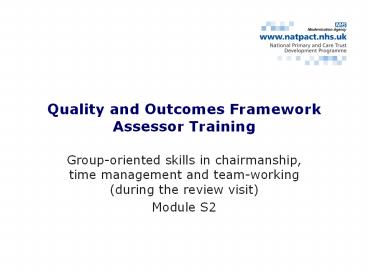Quality and Outcomes Framework Assessor Training PowerPoint PPT Presentation
1 / 12
Title: Quality and Outcomes Framework Assessor Training
1
Quality and Outcomes Framework Assessor Training
- Group-oriented skills in chairmanship, time
management and team-working (during the review
visit) - Module S2
2
Aims of the Module
- To clarify the role and responsibilities of the
Lead assessor - To identify principles for best practice
- To identify practicalities
- To clarify the process of leading and
coordinating the review visit
3
Module outline (One hour)
- The role of the lead assessor
- Preparing for the review visit
- Practicalities
- Setting the tone
- Conducting the review visit
- Sources of information
- Giving feedback to the Practice
- Co-coordinating the report-writing
4
Role of the lead assessor
- To co-ordinate the assessment process
- To ensure adherence to best practice
5
Preparing for the visit
- Good planning is essential!
- Contact the Practice in advance
- Explain process
- Ask who should be interviewed and arrange
timetable - Check for any other issues that might affect the
review
6
Preparation (contd..)
- Meet the Practice Manager
- Introduce the team identify roles and expertise
- Clarify purpose and process
- Plan how the visit will run (timings, etc)
- Agree what information you are seeking
- Agree who will collect what information, and how
(interview, looking at records, etc) - Address any concerns of the team members
7
Practicalities
- Build in time for a Practice walkabout
- Arrange for a private room set aside for
assessors all day - Ensure that at least one assessor can access the
Practice computer system - Manage time carefully (e.g. approx. 20 minutes
per interview) and keep close track of progress
with minimum disruption!
8
Setting the tone
- Remember you are GUESTS in the Practice!
- Treat everyone you meet (staff and patients) with
respect and courtesy smile and say Good
Morning! - Avoid any non-verbal expressions that might
indicate disapproval stay neutral in tone and
manner
9
Conducting the review visit
- Separate to conduct respective interviews,
observations and data gathering - Schedule a time when assessors can meet to review
progress at intervals - If information is unclear or possibly biased, ask
another assessor to explore area further - Ensure assessors are recording their evidence
(noting particular strengths or areas of doubt) - At the end, co-ordinate the views of the
assessors and agree what initial feedback will be
given
10
Sources of information
Robust evidence is essential! Triangulate
information from a variety of sources
- Hard data from (e.g. records, critical incident
register, repeat prescriptions) - Observation (e.g. waiting room telephone manner
team-working) - Interviews (staff and patients)
11
Giving feedback to the Practice
- Some initial feedback is important
- Do this face to face
- Start with the areas of strength
- Then cover any areas for improvement
- Provide recommendations not criticisms
- Make it a dialogue not a monologue!
- Check to see how feedback is being received
- End on a positive note
12
Co-ordinating the report writing
- Agree who will draft the report (if not the Lead)
- Gather all the notes from the assessors
- Agree a mechanism for all members to review the
draft before the final version is sent to the
Practice

